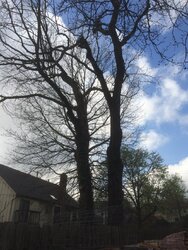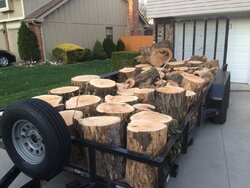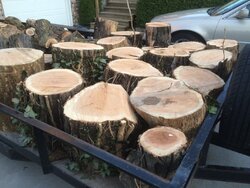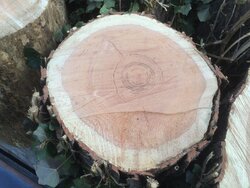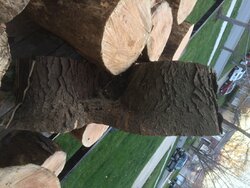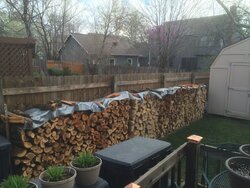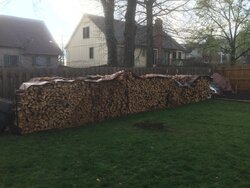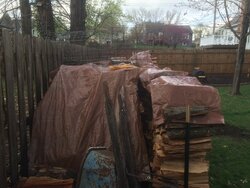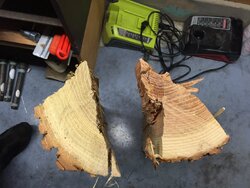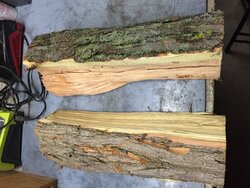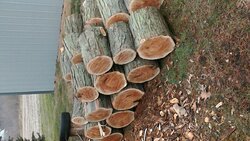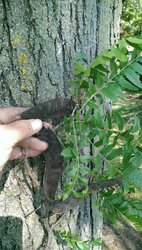I've been watching this double trunk Black Locust in my neighbors backyard die for 4 years. The house was sold 2 months ago and the new owner and I were talking about different things when the conversation got around to his dead tree. Well he had it taken down Friday and I got almost the whole tree, I pulled my trailer into his driveway and the crew cut the trunks into 18" pieces and wheeled the whole tree onto my trailer. I only had to lift the logs that were already in his driveway before I got my trailer on site. I already have eight cords stacked in my back yard, so I took it to my daughters house to be processed. The stacks against the back fence are 34' long, 3 stacks deep. The side fence stack is 24' long. I believe I'm set for several years now.
My neighbor had a tree......
- Thread starter 2PistolPacker
- Start date
-
Active since 1995, Hearth.com is THE place on the internet for free information and advice about wood stoves, pellet stoves and other energy saving equipment.
We strive to provide opinions, articles, discussions and history related to Hearth Products and in a more general sense, energy issues.
We promote the EFFICIENT, RESPONSIBLE, CLEAN and SAFE use of all fuels, whether renewable or fossil.
You are using an out of date browser. It may not display this or other websites correctly.
You should upgrade or use an alternative browser.
You should upgrade or use an alternative browser.
- Status
- Not open for further replies.
claydogg84
Minister of Fire
Claydogg, having no thorn clusters what make you think this is honey locust?
In 40 years of owning timbered Ozark property, I've never seen a thornless honey locust growing in this area although I know they do exist.
In 40 years of owning timbered Ozark property, I've never seen a thornless honey locust growing in this area although I know they do exist.
claydogg84
Minister of Fire
Claydogg, having no thorn clusters what make you think this is honey locust?
In 40 years of owning timbered Ozark property, I've never seen a thornless honey locust growing in this area although I know they do exist.
The bark and color of the wood is wrong for Black Locust. I've only had 1 time I've dealt with Honey Locust and it was also thornless, but I was told it was ornamental.
claydogg84
Minister of Fire
Wrong, the bark and wood color are spot on for black locust.
Black Locust is yellow, and the bark is much thicker, with deep grooves - especially for a tree this size. I'm not trying to start an argument with you, but around 50% of my stacks are BL. If you want to think it's BL, go ahead - But it isn't.
Black locust is almost orange when fresh cut. I've always enjoyed reading your posts, but you don't know what you're talking about.
claydogg84
Minister of Fire
claydogg84
Minister of Fire
Black locust is almost orange when fresh cut. I've always enjoyed reading your posts, but you don't know what you're talking about.
Obviously I've offended you. Maybe someone else will chime in. Either way, nice score.
Scooter422
Burning Hunk
ewlsey
Member
Looks like all the Honey Locust I've ever cut.
It makes no difference. They are almost identical in BTUs. Honey Locust is awesome to work with except the stupid thorns. It splits really easy.
It makes no difference. They are almost identical in BTUs. Honey Locust is awesome to work with except the stupid thorns. It splits really easy.
claydogg84
Minister of Fire
Honey locust, that I'm planning to get soon. Probably a yard variety, there are no thorns on it .
Is this a two year, til seasoned, type of wood?
All of the dense hardwoods will most likely need 2-3 years to hit low 20s on the MM. If you go small on the splits you may be able to get it ready after 1 season.
Last edited:
Scooter422
Burning Hunk
porkchopexpress
Member
Ram 1500 with an axe...
Minister of Fire
More like 3....Honey locust, that I'm planning to get soon. Probably a yard variety, there are no thorns on it .
Is this a two year, til seasoned, type of wood?
Ram 1500 with an axe...
Minister of Fire
Now that's a beautiful sight.....That's honey locust. There are vines in the bark that may be throwing you off. Honey has more plated bark while locust has very deep diamond shaped bark. Good score.
Ram 1500 with an axe...
Minister of Fire
Hey we all make mistakes, no big deal, but I don't think it's BL either, it's usually a nice yellow color with thick crisscrossing bark.... I've also seen greenish wood before..... BL is the best wood I've burned so far.....
BamaScroungr
Burning Hunk
Black locust very deep furrowed bark for that size of tree - green to yellow interior when fresh cut
Honey locust - ornamental variety hybrid no thorns or almost none - particularly the giant clusters- wood interior pink to redish with the prominent light colored band just under the bark - park is plaited almost like silvermaple but muck thicker.
Those pictures posted by the op are classic Honey Locust Hybrid. although the color rendition on my screen is a bit off.
Depending on the chart consulted Honey locust is a few steps up the ladder from Black - Doesn't really matter it is in the top 5 of fire wood in my book
Have both here Black and Honey in my stacks at about a 5 to 1 ratio favoring Honey.
Like Elm, Locust have a bad rap- so I can get a lot of that vs Oak and Hickory which every mother' s son wants.
Short , bit funny from store from a couple nights ago - newish customer was at shop looking for a larger saw for some 5ft trunks pulled one out with a 36" bar- then started rolling a 18" crotch of Honey locust over so he could try it out. So his buddy decides to pick it up - expletives were issued quickly as he was totally caught off guard by its weight asked what is was after he set back down. Anyway it was humorous to me. yep sold the saw also.
Honey locust - ornamental variety hybrid no thorns or almost none - particularly the giant clusters- wood interior pink to redish with the prominent light colored band just under the bark - park is plaited almost like silvermaple but muck thicker.
Those pictures posted by the op are classic Honey Locust Hybrid. although the color rendition on my screen is a bit off.
Depending on the chart consulted Honey locust is a few steps up the ladder from Black - Doesn't really matter it is in the top 5 of fire wood in my book
Have both here Black and Honey in my stacks at about a 5 to 1 ratio favoring Honey.
Like Elm, Locust have a bad rap- so I can get a lot of that vs Oak and Hickory which every mother' s son wants.
Short , bit funny from store from a couple nights ago - newish customer was at shop looking for a larger saw for some 5ft trunks pulled one out with a 36" bar- then started rolling a 18" crotch of Honey locust over so he could try it out. So his buddy decides to pick it up - expletives were issued quickly as he was totally caught off guard by its weight asked what is was after he set back down. Anyway it was humorous to me. yep sold the saw also.
Applesister
Minister of Fire
Its probably a very common confusion to mix these trees up. But neither are related. Okay...someone said they're in the pea family, which they are. They are probably both nitrogen fixing.
Settlers came across the oceans and named both these species after locusts of European origin, also no relation to any of the trees here in the new world other than some similar characteristics.
"Locust" is a generic and historical name for several different unrelated trees.
Honey locust is Locust and Black locust is Locust...hense the argument.
Settlers came across the oceans and named both these species after locusts of European origin, also no relation to any of the trees here in the new world other than some similar characteristics.
"Locust" is a generic and historical name for several different unrelated trees.
Honey locust is Locust and Black locust is Locust...hense the argument.
Applesister
Minister of Fire
Kinda like Tulip poplar...
Tulip tree is not a poplar, its not related at all. Not even in the same ball park.
Trees get classified by how they reproduce. Their seed production. The male and female parts and the seeds.
Sometimes the difference can be microscopic.
Tulip tree is not a poplar, its not related at all. Not even in the same ball park.
Trees get classified by how they reproduce. Their seed production. The male and female parts and the seeds.
Sometimes the difference can be microscopic.
Catia
Member
Newbie here.
Have some locust trees & some questions. I am in PA, & these trees are in fact native to the US & this area.
Mine are black locust, as far as I know, but even if they were honey locust, I wouldn't care one way or the other, because for burning, it's about the same.
I also have black locust posts supporting a beam in my basement & they've been there for about 100 yrs & going strong!
was common in this area for fence posts as well.
My questions are about cutting them up.
We've had some major branches which are huge come down & we've chopped them up with a chainsaw. They were still green, so no issue there. Yes the wood is so heavy- it's like an optical illusion even for small pieces.
I've heard horror stories about how impossible this wood is to cut or split when it is dry, that it eats through chainsaw blades etc. Wood workers only like to work with it when it is still wet, & very few enjoy working with it--though there are a few mills that specialize in locust & mill it -just not near me.
I want to hear from some of you who've cut it & split it yourselves.
I've also read somewhere-not here-to leave the bark on because it is so much easier to let it fall off later.
I have 2 that will be coming down, & another huge beast that fell on a back hill side that my neighbor just left down, that I can have if I want to cut it up. It's been down for a few years--& is the whole tree & probably somewhat dry.
What are your hints/tips & tricks?
from Wikipedia: (which has some really good pics of live trees for reference)
"Robinia pseudoacacia, commonly known as the black locust, is a tree of the genus Robinia in the subfamily Faboideae of the pea family Fabaceae. It is native to the southeastern United States, but has been widely planted and naturalized elsewhere in temperate North America, Europe, Southern Africa [1] and Asia and is considered an invasive species in some areas. Another common name is false acacia,[2] a literal translation of the specific name. It was introduced into Britain in 1636."
& also
"The black locust is native in the United States from Pennsylvania to northern Georgia and westward as far as Arkansas and Oklahoma, but has been widely spread."
Have some locust trees & some questions. I am in PA, & these trees are in fact native to the US & this area.
Mine are black locust, as far as I know, but even if they were honey locust, I wouldn't care one way or the other, because for burning, it's about the same.
I also have black locust posts supporting a beam in my basement & they've been there for about 100 yrs & going strong!
was common in this area for fence posts as well.
My questions are about cutting them up.
We've had some major branches which are huge come down & we've chopped them up with a chainsaw. They were still green, so no issue there. Yes the wood is so heavy- it's like an optical illusion even for small pieces.
I've heard horror stories about how impossible this wood is to cut or split when it is dry, that it eats through chainsaw blades etc. Wood workers only like to work with it when it is still wet, & very few enjoy working with it--though there are a few mills that specialize in locust & mill it -just not near me.
I want to hear from some of you who've cut it & split it yourselves.
I've also read somewhere-not here-to leave the bark on because it is so much easier to let it fall off later.
I have 2 that will be coming down, & another huge beast that fell on a back hill side that my neighbor just left down, that I can have if I want to cut it up. It's been down for a few years--& is the whole tree & probably somewhat dry.
What are your hints/tips & tricks?
from Wikipedia: (which has some really good pics of live trees for reference)
"Robinia pseudoacacia, commonly known as the black locust, is a tree of the genus Robinia in the subfamily Faboideae of the pea family Fabaceae. It is native to the southeastern United States, but has been widely planted and naturalized elsewhere in temperate North America, Europe, Southern Africa [1] and Asia and is considered an invasive species in some areas. Another common name is false acacia,[2] a literal translation of the specific name. It was introduced into Britain in 1636."
& also
"The black locust is native in the United States from Pennsylvania to northern Georgia and westward as far as Arkansas and Oklahoma, but has been widely spread."
claydogg84
Minister of Fire
Newbie here.
Have some locust trees & some questions. I am in PA, & these trees are in fact native to the US & this area.
Mine are black locust, as far as I know, but even if they were honey locust, I wouldn't care one way or the other, because for burning, it's about the same.
I also have black locust posts supporting a beam in my basement & they've been there for about 100 yrs & going strong!
was common in this area for fence posts as well.
My questions are about cutting them up.
We've had some major branches which are huge come down & we've chopped them up with a chainsaw. They were still green, so no issue there. Yes the wood is so heavy- it's like an optical illusion even for small pieces.
I've heard horror stories about how impossible this wood is to cut or split when it is dry, that it eats through chainsaw blades etc. Wood workers only like to work with it when it is still wet, & very few enjoy working with it--though there are a few mills that specialize in locust & mill it -just not near me.
I want to hear from some of you who've cut it & split it yourselves.
I've also read somewhere-not here-to leave the bark on because it is so much easier to let it fall off later.
I have 2 that will be coming down, & another huge beast that fell on a back hill side that my neighbor just left down, that I can have if I want to cut it up. It's been down for a few years--& is the whole tree & probably somewhat dry.
What are your hints/tips & tricks?
from Wikipedia: (which has some really good pics of live trees for reference)
"Robinia pseudoacacia, commonly known as the black locust, is a tree of the genus Robinia in the subfamily Faboideae of the pea family Fabaceae. It is native to the southeastern United States, but has been widely planted and naturalized elsewhere in temperate North America, Europe, Southern Africa [1] and Asia and is considered an invasive species in some areas. Another common name is false acacia,[2] a literal translation of the specific name. It was introduced into Britain in 1636."
& also
"The black locust is native in the United States from Pennsylvania to northern Georgia and westward as far as Arkansas and Oklahoma, but has been widely spread."
You won't have any issues cutting up the tree when dead, or "dry". It does seem to be easier on the chain when wet, but that isn't really a big deal. The bark will also fall off as the wood seasons, so no real reason to try and remove it while splitting.
- Status
- Not open for further replies.


